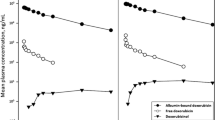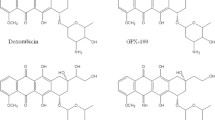Summary
The pharmacokinetics of doxorubicin (DOX), iodo-doxorubicin (I-DOX) and their metabolites in plasma has been examined in five patients each receiving 50 mg/m2 of both anthracyclines as a bolus injection.
Terminal half-life, mean residence time (MRT), peak plasma concentration Cmax, and area under the curve (AUC) appeared smaller for I-DOX, whereas its plasma clearance (CLp) and volume of distribution at steady state (Vss) were larger than for DOX.
The major metabolite of I-DOX was iodo-doxorubicinol (I-AOL) followed by doxorubicinol aglycone (AOLON). The AUC of I-AOL was 6-times larger than that of its counterpart AOL, which is the major metabolite of DOX. AOLON generated after I-DOX administration is a further important metabolite, as its AUC was 10-times larger than that of AOLON generated from DOX.
The other aglycones, such as doxorubicin aglycone (AON) and the 7-deoxy-aglycones were only minor metabolites after either I-DOX or DOX injection. The ratio AUCI-AOL/AOL/AUCI-DOX/DOX was 27 in the case of I-DOX and 0.4 after DOX.
The terminal half-lives of the cytostatic metabolites I-AOL and AOL were similar, although a longer MRT for AOL was calculated. Both metabolites had much longer MRTs than their parent drugs. The MRTs of the aglycones AOLON and AON were greater than those of the 7-deoxy-aglycones after both I-DOX and DOX.
Approximately 6% DOX and less than 1% I-DOX were excreted by the kidneys during the initial 48 h. About 5% of I-DOX was excreted via the kidneys as I-AOL. Aglycones were not detected in significant amounts.
The plasma concentrations of all compounds measured were highest during the first few minutes after administration of I-DOX and DOX. The I-AOL concentration was comparable to that of I-DOX immediately after the injection, due to very rapid metabolism within the central compartment (vascular space) by the aldoketo reductase system in the erythrocytes. The plasma concentration-time curves of (7d)-aglycones showed a second peak between 2 and 9 h after injection, suggesting enterohepatic circulation of metabolites lacking the daunosamine sugar moiety.
Similar content being viewed by others
References
Wein RB, Sarosy G, Clagett-Carr K, Russo M, Leyland-Jones B (1986) Anthracycline analogs: the past, present and future. Cancer Chemother Pharmacol 18: 185–197
Denchars KL, Ling V (1989) P-glycoprotein and multidrug resistance in cancer chemotherapy. Semin Oncol 16: 156–165
Mross K, Maessen P, van der Vijgh WJF, Gall H, Boven E, Pinedo HM (1988) Pharmacokinetics and metabolism of epidoxorubicin and doxorubicin in humans. J Clin Oncol 6: 517–526
Cersosimo R, Ki Hong W (1986) Epirubicin: a review of the pharmacology, clinical activity, and adverse effects of an adriamycin analog. J Clin Oncol 4: 425–439
Coley HM, Twentyman PR, Workman P (1989) Identification of anthracyclines and related agents that retain preferential activity over adriamycin in multidrug-resistant cell lines, and further resistance modification by verapamil and cyclosporin A. Cancer Chemother Pharmacol 24: 284–290
Gianni L, Vigano L, Surbane A, Ballinari D, Casali P, Tarella C, Collins JM, Bonadonna G (1990) Pharmacology and clinical toxicity of 4′-iodo-4′-deoxydoxorubicin: An example of successful application of pharmacokinetics to dose escalation in Phase-I trials. J Nat Cancer Inst 82: 469–477
Mross K, Langenbuch T, Burk K, Kaplan E, Hossfeld DK (1989) Phase I study of iodo-doxorubicin (4′-I-DOX) in solid tumors. Proceedings of ASCO, vol 8, no 304
Barbieri B, Guiliani FC, Bordoni T, Casazza AM, Geroni C, Bellini O, Suarato A, Gioia B, Penco S, Arcamone F (1987) Chemical and biological characterization of 4′-iodo-4′-deoxy-doxorubicin. Cancer Res 47: 4001–4006
Supino R, Mariani M, Prosperi E, Parmiani G (1988) Lack of cross-resistance of a doxorubicin-resistant B16 melanoma line with 4′-deoxy-4′-iodo-doxorubicin. Cancer Chemother Pharmacol 21: 251–254
Takanashi S, Bachur NR (1976) Adriamycin metabolism in man. Drug Metabol Disposit 4: 79–87
Formelli F, Carsana R, Pollini C (1987) Pharmacokinetics of 4′-deoxy-4′-iodo-doxorubicin in plasma and tissue of tumor-bearing mice compared with doxorubicin. Cancer Res 47: 5401–5406
Mross K, Mayer U, Hamm K, Hossfeld DK (1990) High-performance liquid chromatography analysis of iodo-doxorubicin and fluorescent metabolites in plasma samples. J Chromatography 530: 192–199
Arcamone F (1985) Properties of antitumor anthracyclines and new developments in their application. Cancer Res 45: 5995–5999
Sjöqvist T, Borga O, Orme MLE (1976) Fundamentals of clinical pharmacology. In: Avery GS (ed) Drug treatment. Principles and practice of clinical pharmacology and therapeutics, Adis Press, Sydney
Brenner D, Grosh WW, Noone R (1984) Human plasma pharmacokinetics of doxorubicin: Comparison of bolus and infusional administration. Cancer Treat Symp 3: 77–83
Schott B, Vrighaud P, Ries C, Robert J, Londos-Gagliardi D (1990) Cellular pharmacology of 4′-iodo-4′-deoxydoxorubicin. Br J Cancer 61: 543–547
Smith DB, Margison JM, Lucas SB, Wilkinson PM, Howell A (1987) Clinical pharmacology of oral and intravenous 4-deme-toxydaunorubicin. Cancer Chemother Pharmacol 19: 138–142
Rowland IR (1986) Reduction by the gut microflora of animals and man. Biochem Pharmacol 35: 27–32
Schwartz JE, Salmon SE (1987) Comparative in vitro activity of 4′-deoxy-4′-iodo-doxorubicin and other anthracyclines in the human tumor clonogenic assay. Invest New Drugs 5: 231–234
Lerza R, Bogliolo M, Saviane A, Muzzulini C, Pannacciulli R (1988) Experimental comparative study on myelotoxicity of 4′-deoxy-4′-iodo-doxorubicin and doxorubicin. Chemother 34: 354–359
Villani F, Galimberti M, Lanza E, Rozza A, Favalli L, Poggi P (1988) Evaluation of cardiotoxicity of a new anthracycline derivative: 4′-deoxy-4′-iodo-doxorubicin. Invest New Drugs 6: 173–178
Gigli M, Ragoanaivo E, Millot JM, Jeannessou P, Rizzo V, Jardillier JC, Arcamone F, Manfait M (1989) Correlation between growth inhibition and intra nuclear doxorubicin and 4′-deoxy-4′-iodo-doxorubicin quantitated in living K562 cells by microspectrofluorometry. Cancer Res 49: 56–564
Mross K, Langenbuch T, Burk K, Mayer U, Kaplan E, Hossfeld DK (1989). Phase I study with iodo-doxorubicin. Contrib Oncol 37: 64–73
Maessen PA, Mross KB, Pinedo HM, van der Vijgh WMF (1987) Metabolism of epidoxorubicin in animals: absence of glucuronidation. Cancer Chemother Pharmacol 20: 85–87
Author information
Authors and Affiliations
Rights and permissions
About this article
Cite this article
Mross, K., Mayer, U., Hamm, K. et al. Pharmacokinetics and metabolism of iodo-doxorubicin and doxorubicin in humans. Eur J Clin Pharmacol 39, 507–513 (1990). https://doi.org/10.1007/BF00280945
Received:
Accepted:
Issue Date:
DOI: https://doi.org/10.1007/BF00280945




